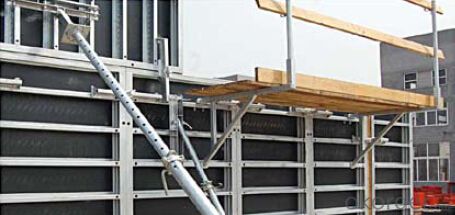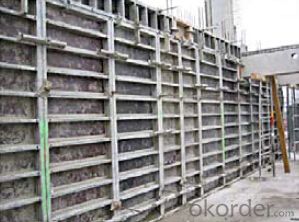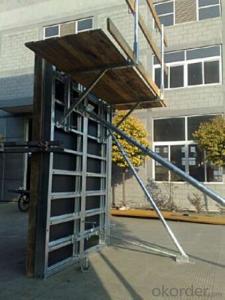Steel-frame Formwork Platform
- Loading Port:
- China Main Port
- Payment Terms:
- TT OR LC
- Min Order Qty:
- -
- Supply Capability:
- -
OKorder Service Pledge
OKorder Financial Service
You Might Also Like
Steel-frame Formwork SF-140
Characteristics:
◆ Few parts for fast forming.
◆ Max. Concrete pressure: 80KN/m2.
◆ Hot-dip galvanized steel frame.
◆ The thickness of plywood is 18mm & the panel is 14cm.
◆ Compatibility with Hunnebeck Manto system due to similar edge profile.
System Details & Application:
◆ Neat joint and fast assembling with aligning panel clamp.
◆ Flexible panel arrangement and height extension.
◆ The selection of panels.
◆ Kinds of panel connectors.
◆ Corner clamp application.
◆ Length adjustment application.
◆ Height adjustment & aligning strut.
◆ Walkway bracket & platform.




- Q:How does steel formwork handle different concrete surface treatments?
- Steel formwork is highly versatile and can handle different concrete surface treatments effectively. The smooth and rigid nature of steel formwork allows for the application of various surface treatments, such as textured finishes, exposed aggregate, or decorative patterns, without compromising the quality or integrity of the concrete. Steel formwork provides a stable and durable framework that ensures the desired surface treatment remains intact during the concrete pouring and curing process. Furthermore, the reusability of steel formwork allows for consistent and reliable results across multiple projects with different concrete surface treatments.
- Q:Can steel formwork be used for hotel construction projects?
- Indeed, hotel construction projects can make use of steel formwork. This adaptable and enduring solution is ideal for the creation of concrete structures, including hotels. It boasts numerous benefits, including exceptional strength, durability, and the ability to be reused. Steel formwork can withstand the immense pressure exerted by wet concrete and can be effortlessly assembled and disassembled, making it highly suitable for a range of construction endeavors, such as hotels. Moreover, it imparts a sleek and precise finish to concrete structures, guaranteeing construction of the utmost quality.
- Q:How does steel formwork affect the overall project cost?
- Steel formwork can have a significant impact on the overall project cost. It is generally more expensive to use steel formwork compared to other alternatives such as wood or aluminum. However, there are several factors that need to be considered when evaluating the cost-effectiveness of using steel formwork. Firstly, steel formwork is known for its durability and longevity. Unlike wood, steel formwork can be reused multiple times, which can lead to cost savings in the long run. It requires less maintenance and repairs, reducing the need for frequent replacements. This can be particularly advantageous for projects that involve repetitive use of formwork. Secondly, steel formwork offers better quality and precision in terms of concrete finishing. It provides a smoother surface and accurate dimensions, resulting in reduced need for additional finishing work. This can help save both time and money during the construction process. Moreover, steel formwork allows for faster construction compared to other types of formwork. It is quick to assemble and dismantle, enabling faster turnaround times. This can have a positive impact on the overall project schedule and potentially reduce labor costs. Additionally, steel formwork is more resistant to factors such as weather conditions, high pressure, and vibrations. This enhances the overall structural integrity of the concrete, reducing the risk of defects and potential rework. By minimizing the need for corrective actions, steel formwork can help control project costs. However, it is important to note that the cost of steel formwork can vary depending on the project size, complexity, and duration. For smaller projects with limited use of formwork, the cost difference between steel and other materials may not be significant. In such cases, it may be more cost-effective to opt for alternative formwork options. In conclusion, while steel formwork may have a higher upfront cost compared to other materials, its durability, precision, speed, and long-term reusability can contribute to cost savings throughout the project. It is essential to carefully evaluate the specific requirements and circumstances of each project to determine the most cost-effective formwork solution.
- Q:Is steel formwork suitable for projects with limited skilled labor?
- Yes, steel formwork is suitable for projects with limited skilled labor. Steel formwork is a pre-fabricated system that can be easily assembled and dismantled, making it user-friendly even for unskilled laborers. It does not require extensive training or specialized skills to work with steel formwork. Additionally, steel formwork is highly durable and can be reused multiple times, providing cost-effectiveness and reducing the need for skilled labor throughout the project. The strength and stability of steel formwork also ensure accurate and precise construction, even with limited skilled labor. Therefore, steel formwork is a suitable choice for projects where skilled labor is limited, as it allows for efficient and reliable construction without compromising the quality of the project.
- Q:How does steel formwork contribute to sustainable construction?
- There are several ways in which steel formwork contributes to sustainable construction: 1. Enhanced Durability: Steel formwork boasts remarkable durability and can be utilized multiple times, thereby minimizing the need for frequent replacements. This results in reduced material consumption and waste generation, making it an environmentally conscious choice. 2. Energy Efficient: In comparison to materials like wood or plastic, steel formwork requires less energy during the manufacturing process. As a result, it contributes to lower carbon emissions, thereby aiding in the reduction of greenhouse gas emissions. 3. Waste Minimization: By employing steel formwork, construction waste is minimized. Unlike traditional formwork materials that are often discarded after a single use, steel formwork can be easily disassembled, cleaned, and reused for future projects. This reduces the amount of waste sent to landfills and supports the concept of a circular economy. 4. Accelerated Construction Speed: Steel formwork is renowned for its speed and efficiency in construction projects. Its modular design allows for swift assembly and disassembly, thereby reducing construction time and energy consumption. Consequently, this minimizes disruption to the surrounding environment and lowers the overall carbon footprint of the project. 5. Enhanced Safety: Steel formwork provides a stable and secure platform for construction workers during the building process. Its strength and rigidity mitigate the risk of accidents and injuries, ensuring a safer working environment. This, in turn, leads to reduced healthcare costs and increased worker productivity. In summary, the utilization of steel formwork in construction promotes sustainability by diminishing waste, energy consumption, and carbon emissions. Its durability, reusability, and efficiency make it an invaluable option for sustainable construction practices.
- Q:Can steel formwork be used for sports complex construction projects?
- Yes, steel formwork can be used for sports complex construction projects. Steel formwork is a versatile and durable option for creating temporary molds or structures for casting concrete. Its strength and flexibility make it suitable for various construction projects, including sports complexes. Steel formwork can provide the necessary support and stability required during the construction process, ensuring the efficient and accurate placement of concrete in complex shapes and designs.
- Q:What are the common safety certifications required for steel formwork?
- To ensure the utmost safety on construction sites, steel formwork often necessitates various safety certifications. These certifications encompass the following: 1. OSHA Certification: The steel formwork must possess the Occupational Safety and Health Administration (OSHA) certification. This certification guarantees compliance with OSHA's safety standards, encompassing fall protection, proper scaffolding, and other safety measures. 2. ANSI Certification: Another indispensable requirement is the American National Standards Institute (ANSI) certification for steel formwork. ANSI establishes standards for diverse aspects of construction safety, including materials, equipment, and worker protection. An ANSI certification confirms conformity with these standards. 3. CSA Certification: When employing steel formwork in Canada, the Canadian Standards Association (CSA) certification is usually obligatory. This certification ensures compliance with CSA's safety standards, encompassing design, materials, and structural integrity. 4. CE Marking: The CE marking is an imperative certification for steel formwork employed in the European Union and other countries adhering to European standards. It signifies adherence to the European Union's essential health, safety, and environmental protection requirements. 5. ISO Certification: Although not directly related to safety, an ISO certification signifies that the manufacturer of the steel formwork has implemented a quality management system conforming to the International Organization for Standardization (ISO) standards. This certification guarantees consistent production of the formwork, meeting specific quality requirements. It is crucial to acknowledge that the precise certifications required for steel formwork may vary depending on the country, region, or project specifications. Consequently, consulting local regulations and project specifications is essential to determine the exact certifications necessary for steel formwork in a specific context.
- Q:Can steel formwork be used for curved or irregular-shaped structures?
- Yes, steel formwork can be used for curved or irregular-shaped structures. Unlike traditional timber formwork, steel formwork offers greater flexibility and strength, making it suitable for complex shapes and designs. Steel formwork can be easily bent or fabricated into the desired shape, enabling the construction of curved walls, columns, and slabs. Additionally, steel formwork provides excellent support and stability, ensuring the accuracy and precision of the final structure. Its durability and reusability further make it a cost-effective choice for projects involving curved or irregular-shaped structures.
- Q:Can steel formwork be used for architectural concrete slabs?
- Architectural concrete slabs can indeed utilize steel formwork. When compared to other formwork materials, steel formwork boasts numerous advantages in terms of its strength, durability, and versatility. By providing a rigid structure, it can effectively withstand the pressure exerted by fresh concrete, thereby guaranteeing accurate and precise placement of the slabs. Moreover, steel formwork can be conveniently reused multiple times, rendering it both cost-effective and environmentally friendly. Its smooth surface further contributes to the attainment of high-quality finishes for architectural concrete slabs. Nevertheless, it remains crucial to ensure proper insulation and the use of release agents to prevent heat transfer and potential concrete adherence issues caused by the steel. All in all, steel formwork proves to be a dependable and efficient choice for the creation of architectural concrete slabs.
- Q:Can steel formwork be used for both simple and complex architectural designs?
- Yes, steel formwork can be used for both simple and complex architectural designs. Steel formwork offers excellent strength and durability, allowing it to handle complex shapes and intricate details with ease. It can be easily assembled and disassembled, making it suitable for various design requirements. Additionally, steel formwork provides a smooth and uniform finish, ensuring high-quality results for both simple and complex architectural designs.
1. Manufacturer Overview |
|
|---|---|
| Location | |
| Year Established | |
| Annual Output Value | |
| Main Markets | |
| Company Certifications | |
2. Manufacturer Certificates |
|
|---|---|
| a) Certification Name | |
| Range | |
| Reference | |
| Validity Period | |
3. Manufacturer Capability |
|
|---|---|
| a)Trade Capacity | |
| Nearest Port | |
| Export Percentage | |
| No.of Employees in Trade Department | |
| Language Spoken: | |
| b)Factory Information | |
| Factory Size: | |
| No. of Production Lines | |
| Contract Manufacturing | |
| Product Price Range | |
Send your message to us
Steel-frame Formwork Platform
- Loading Port:
- China Main Port
- Payment Terms:
- TT OR LC
- Min Order Qty:
- -
- Supply Capability:
- -
OKorder Service Pledge
OKorder Financial Service
Similar products
New products
Hot products
Related keywords
























